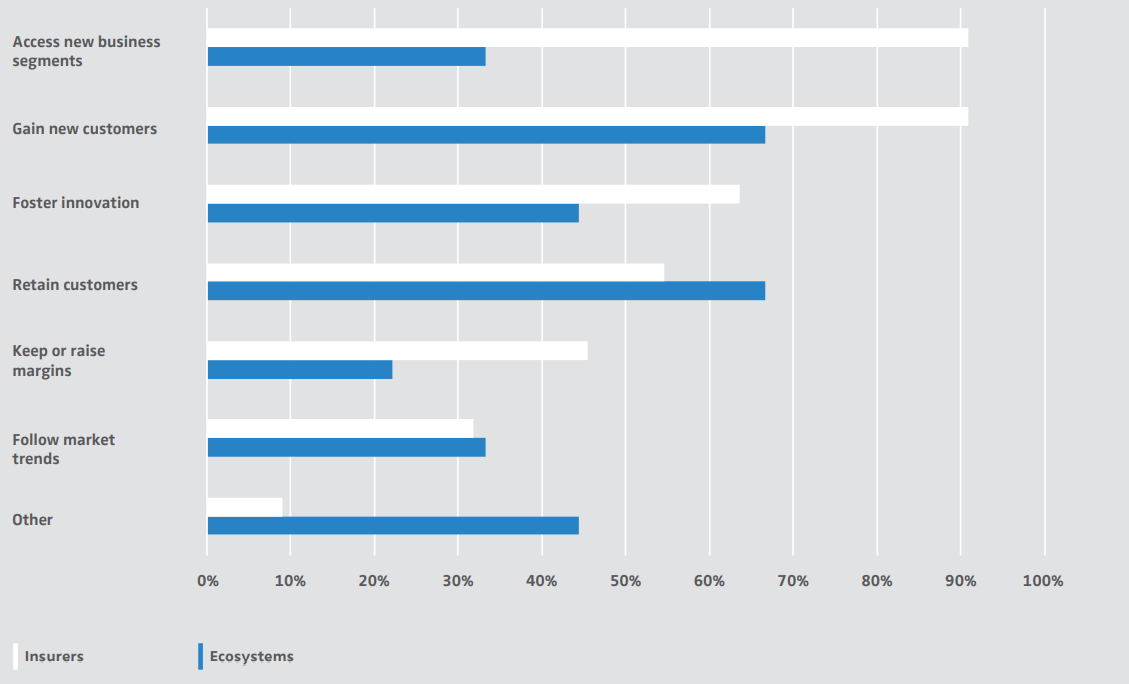This study deals with two questions – to what extent do platform-based ecosystems form the basis of new business models and what are their implications for insurers?
The use of digital technologies in insurance often occurs in confined areas of application. Legacy systems are replaced or modularised, which is a massive undertaking. Existing processes are automated or various tools are introduced for specific tasks. Increasingly, interfaces for third-party interaction are also introduced.
As important as these investments are, they must be seen as preparatory work for a phase that will potentially bring about far-reaching changes in the industry and its players. This phase is no longer about optimising existing business models, but about being able to exploit the potential of new ones.
Despite recent price corrections in the technology sector, four of the world’s five most valuable companies are based on digital platforms with ecosystems built around them. The high valuations have a lot to do with the fact that these companies have managed to become a global standard for a certain sector of society, by making the customer interface user-friendly and by tapping into relevant parts of the value chain of other companies that must now bow to these standards.
So, today, any offer that needs to be mobile-capable cannot avoid following the iOS standards and paying Apple’s fees. Numerous innovations are bundled in one customer interface on these platforms. They appear very innovative from the customer’s point of view, even if the underlying technology (e.g., the Microsoft Office package), is by necessity, quite stable.
But what does this have to do with insurance?
Can insurers also become such dominant players?
And, if not, are they doomed to become low-margin suppliers?
This year’s study shows that the insurers’ destiny doesn’t have to be so binary. It also shows that it is not so much about building an ecosystem by hook or by crook, and thereby positioning oneself as a spider in the middle of a web. Rather, it is once again about delivering real added value for customers as well as doing this with ample confidence in one’s own strengths and certain modesty.
After all, insurance companies should not always do everything themselves, as in the ecosystem, many participants come together to create the customer value that a single company could never provide alone.
«The topic of ecosystems is very important to me because it is becoming increasingly difficult to reach customers in the traditional way.»
In last year’s study, we defined different roles for today’s insurance industry: supplier, boutique, or orchestrator. The central question in the strategic objective was the customer interface. Is the insurance sold in a package with the main product? Is the customer interface, therefore, lost for the insurer? Or, does it go in the other direction, with the insurance company acting as an aggregating customer advisor, deepening the customer interface?
This year’s study shows that the different roles and paths taken within an ecosystem are more diverse than the simple triad of supplier-boutique-orchestrator would suggest. But it also shows that this complexity quickly becomes clearer when you look at it from the customer’s point of view, specifically in the context of the customer journey.

Customer journey – opportunities for the insurance industry
Other industries are exploiting the possibilities of digitalisation more broadly and more deeply than insurance, and insurance customers are aware of this. In advanced ecosystems – say, in the entertainment industry – customers are becoming used to receiving a certain service with all its components at a single point of sale. They are also supported over the lifetime of this service.
This is where the new mindset comes in: focusing on the entire customer journey from the customer’s perspective. In turn, this means that insurers should prioritise customer lifetime value to retain existing customers.
At the moment, the emphasis and incentive systems are still focused on new business. If the market doesn’t grow, you can only get customers from your competitors, and they in turn can do the same thing. The alternative is to focus on existing customers and serve them as well as possible to keep them for longer. Ecosystems are suitable for this.
The following examples show what this can look like:
1. Motor
This is one of the most-cited insurance ecosystems. The car dealer owns the customer interface and sells the car. In the ‘best’ case, the insurance appears in a paragraph under its own brand in the contract, whilst in the ‘worst’ case, it hides behind a check mark. This is a prime example of the supplier role.
Whilst it might be rare in the market, a different arrangement is conceivable, at least as a thought experiment. The insurer acts as the aggregator of an extended transport ecosystem that sells bicycles, motorbikes, cars, public transport, and others as a package, with the individual transport services furnished by suppliers, such as car rental companies or ride-share providers, and so on. This could operate at a multinational level.
From the point of view of the customer journey over time and in view of the data capabilities of new IT systems, an offering like those would become possible.
In the “home” ecosystem, in particular, I see opportunities to take on a broader role as an insurer. Because as property owners, we can both finance and insure.
2. Home
In addition to classic household contents insurance, insurers often appear in various places in this business area. They offer their own or third-party mortgages and are among the largest real estate owners. This puts them in a stronger position than in the motor arena.
Household contents insurance is not the most sensitive thing about living in a home – until there are damages. Here, the ‘single point of sale’ is less important than the ‘single point of service’. The classic policy that covers all items is more practical than individual ones that are sold with the bed at the furniture store.
In general, there is little recognition of the potential for insurers in the area of claims. It is not only possible but extremely efficient to operate as an ecosystem in claims, under the management of the insurer and with a direct customer or contractual partner interface. This is where insurance companies have a real opportunity to occupy a larger segment of the customer journey and play a more prominent role. We wouldn’t be surprised if there is a sudden breakthrough in this space.
3. Pension provision
This area seems predestined for insurance companies – and for insurance ecosystems. It is, therefore, not surprising that we were able to see more advances here from some market participants, including initiatives to establish themselves as aggregators. However, it is also evident that people from outside the industry have managed to occupy this opportunity. This is a clear example of forced development or the active filling of roles in a pattern provided by the market. This reflects the opportunity cost of missed preparation.
However, we still see great potential for insurance companies here.
It is a great challenge to be able to cover the entire customer journey digitally. With our range of products, we could easily be three companies. This is a long process. It is important to have a clear focus on the customer segment.
Our conclusion for the insurance industry
Compared to last year’s edition, some issues have been refined in this study. The contours of the growing paradigm shift have also become clearer. We found that the distribution of roles in the new world will be more complex than we initially thought, and it is harder to transfer to the existing market and company structures.
In concrete terms, today’s companies will need to combine several roles depending on the business area, which poses considerable challenges for management. In the medium to long term, this could result in organisational, strategic centrifugal forces that call into question today’s company landscape.
Missing out on these trends could be disastrous. Contact us if you would like to discuss further details of the study and what it means for your business. In the meantime, you can download our latest study.

